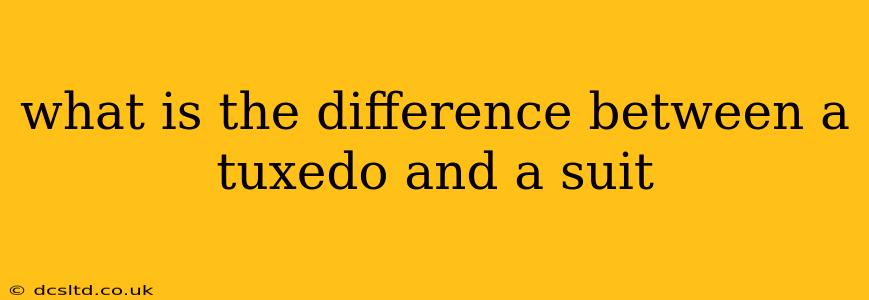What's the Difference Between a Tuxedo and a Suit? A Definitive Guide
The tuxedo and the suit are both formal menswear staples, but they possess distinct characteristics that set them apart. While both are worn for occasions demanding a polished appearance, understanding their subtle differences is crucial for choosing the right attire. This guide will delve into the key distinctions, answering common questions along the way.
What Makes a Tuxedo a Tuxedo?
A tuxedo, also known as a dinner jacket, is characterized by several key features that differentiate it from a standard suit:
-
Peak or Shawl Lapels: Tuxedos almost always feature either peak lapels (pointed) or shawl lapels (rounded). These lapels are typically made of satin or grosgrain, adding a touch of sheen. This is a defining feature; you won't find these types of lapels on a standard suit.
-
Satin or Grosgrain Accents: Beyond the lapels, tuxedos often incorporate satin or grosgrain trim on the buttons, pockets, and sometimes even down the side of the trousers. This adds to the formal, elegant look. Suits generally lack these shiny accents.
-
Specific Button Style: While suits can have various button styles, tuxedos typically use covered buttons—buttons that are themselves fabric-covered to match the lapels. This subtle detail contributes to the overall polished look.
-
Typically Worn with Bow Tie: While a necktie can be worn with some very informal tuxedos, the traditional pairing is a bow tie. This further distinguishes the tuxedo from the suit.
What Makes a Suit a Suit?
A suit, in contrast, is a more versatile garment. It lacks the distinctive features of a tuxedo, exhibiting:
-
Notched or other Lapels: Suits commonly feature notched lapels (the most common), but can also include other styles like peak lapels (though less common than on tuxedos) or even rounded lapels. The key difference is the absence of satin or grosgrain on these lapels.
-
No Satin or Grosgrain Accents: Suits are generally made from a single fabric, lacking the shiny accents that define a tuxedo.
-
Variety of Button Styles: Suits have a broader range of button styles, including two-button, three-button, and single-button options.
-
Typically Worn with a Necktie: A necktie is the standard accompaniment for a suit, though bow ties can be worn in certain contexts.
What Are the Different Types of Tuxedos?
While the core features remain consistent, there are variations in tuxedo styles:
-
Single-breasted: The most common style, featuring a single row of buttons.
-
Double-breasted: A more formal style with a double row of buttons.
-
Black tie (Formal): This strictly adheres to the traditional black tuxedo with black bow tie and accessories.
-
Creative Black Tie: This offers slightly more flexibility, allowing for variations in color, fabric, and accessories, while still maintaining a formal feel.
What is the Proper Etiquette for Wearing a Tuxedo?
Tuxedos are generally reserved for formal occasions such as black-tie events, galas, weddings, and certain high-end corporate events. Always check the invitation for the dress code to ensure a tuxedo is appropriate.
When Should I Wear a Suit Instead of a Tuxedo?
Suits are far more versatile and appropriate for a wider range of occasions, including business meetings, job interviews, weddings (unless black tie is specified), and semi-formal events.
Can I Wear a Tuxedo to a Wedding?
You certainly can, but only if the invitation explicitly states "black-tie" or "black-tie optional." If the dress code is less formal, a suit is a much safer bet. Wearing a tuxedo to a less formal event can seem out of place or even overly pretentious.
In short, while both are formal garments, the tuxedo is a far more specific and formal outfit compared to the suit, readily identified by its signature satin or grosgrain accents and typically paired with a bow tie. Choosing the right attire hinges on understanding the nuances of each garment and the formality of the occasion.
